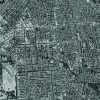It is easy to conclude that Edward George Barnard MP is memorialised in Barnard Street, North Adelaide simply because he was one of the South Australian commissioners. While this is true to a point, it has to be remembered that unlike many of the others named in Adelaide’s streets, he was not a nominee from the ranks of the South Australian Association, but rather he was an appointee from Lord Glenelg’s Colonial Office.
This preferment was due in large part to the fact that not long after Barnard had won the seat of Greenwich in the Reform Parliament of 1832, he was appointed to the Colonial Office as Agent General for the British Colonies, where he had specific oversight of financial and other matters in both New South Wales (NSW) and Van Diemen’s Land. Once appointed to the Commission, his expertise on banking, shipbuilding and colonial matters was immediately put to good use, and he was given the responsibility of chairing the finance committee for the South Australian Colonization Commission in the lead up to departure for the colony in 1836.
Edward George Barnard was the last in a four-generation dynasty of Barnards, who presided over a huge shipbuilding enterprise which saw dozens of ships built for both the Royal Navy and the East India Company. His great-grandfather, John Barnard, the elder, born in 1665, started building ships in a small way at the St Clements yards on the River Orwell, in Ipswich before moving to the King’s naval yard in Harwich. The Barnard dynasty spent several decades there before finally settling at Deptford, on the Thames. For more than a hundred years at Deptford the Barnard dynasty assembled and managed a shipwright industry almost unequalled in Britain, making them integral to Britain’s naval dominance and world maritime supremacy.
If shipbuilding held the Barnard family together for four generations, then so too did a strong and vibrant membership of the dissenting church. The first tangible reference to this family appears in the ‘Book of Admissions’ to the Dissenters Chapel in Tacket Street, Ipswich on 4 August 1697, when John Barnard (the elder) joined the congregation. In a synergy not dissimilar to the commitment that George Fife Angas showed to his businesses and his God, the shipbuilding Barnards sustained a continuing interest in this small congregation for the next 100 years.
Edward George Barnard was born to William and Frances Barnard in 1778. He was the younger of two brothers, William Jnr being two years his senior. There were three sisters: Anne, Frances and Elizabeth. Edward’s parents married on 16 October in 1760 and by 1763 his father had broken from the shipyards at King’s Yard, Harwich and launched into business for himself. He took a thirty-year lease from the Evelyn Estates of a shipyard in Grove Street, Deptford. Business thrived and the two boys, William Jnr and Edward George, were raised to the gentle lapping of the river, the clang of hammers, the rasping of sawyers and the splash of large timbers.
In 1785 Edward’s father was doing so well that he was appointed sole shipwright to His Majesty’s Customs for the Port of London. It wasn’t to last. In the 1790s he succumbed to a protracted illness, passing on 6 March 1795. Frances and the two boys, who were 19 and 17 respectively, assumed the mantle and the business became known as Frances Barnard Sons and Co. In 1803 Edward’s mother moved to Ravensby manor house, Mitcham, in the County of Surrey where for a time she managed the financial affairs of the company before withdrawing to a more leisurely lifestyle. Both boys had been undertaking apprenticeships as shipwrights. William Jnr assumed leadership and took over the day-to-day operations of the shipyards. This provided Edward George the opportunity to explore other avenues of human endeavour, and it is likely that his political persona and reformist disposition began to emerge during this period.
However, his destiny with the shipyard was yet to conclude. Unexpectedly, after a successful eleven-year period for the company, in which older brother William presided over the construction of 25 large ships, most of them Indiamen up to 1,300 tons, William Barnard Jnr died unexpectedly at age 29. This was a calamity and thrust Edward George into the limelight. William Jnr’s last will and testament set aside his share of the Rotherhithe Shipyard for his cousin, Edward Clarke, with the proviso that his brother Edward George be allowed to purchase the share outright within a twelve-month period, should he so wish. Edward George Barnard took up the option, purchased the share and assumed directorship of the entire Barnard shipbuilding business. There is no evidence to suggest that he wasn’t keen to do this.
With the passing of the Napoleonic wars and the enforced retirement of much of Britain’s navy, this was not a good time to be taking over a declining business. Metaphorically, the industry was sinking.
With the death of his mother in 1825, Edward George Barnard became a wealthy man. He slowly set aside shipbuilding and assumed the role of a country gentleman. The shipyards remained open but steadily languished until the late 1830s. Edward turned his attention to politics at this time.
Soon after his mother’s death he purchased Gosfield Hall, in Halstead, Essex. This was a substantial seat of 2,718 acres divided into nine farms and some attractive woodland and parkland dating back to Queen Elizabeth I. Overlooking a large lake, the house was built by Sir John Wentworth in the mid-sixteenth century. There have been six owners in its lifetime, the most notable being the family of the Duke of Buckingham. Between 1807 and 1809 Gosfield provided refuge for King Louis XVIII while he was in exile from revolutionary France.
The metamorphosis of Barnard at this point is of special interest. The upheaval throughout Britain following the Napoleonic wars, the increasing unemployment arising from industrialisation and the pressure for wider political enfranchisement spawned an uneasiness which ensured social turmoil. Political change became inevitable and the surge to reform, albeit of a less disruptive clamour than that across the Channel in France, reverberated through the land.
As an employer in the shipbuilding industry and probably elsewhere. Edward’s familial heritage and progressive ideas of reform had permeated among his workers on his newly acquired lands and farms. It was entirely logical therefore for him to exercise the ‘living’ associated with the Gosfield parish and seek a seat in the Reform Parliament as a Whig representing the new seat of Greenwich. A groundswell of support from those around him urged him on and he went to the polls full of enthusiasm.
On 7 April 1827, at the advanced age of 49, he took his first wife, Eliza Millard, a Jamaican-born woman of childbearing age who bore him two children, Edward George Jnr and a daughter of which there is no record. With complete control of the Barnard legacy, Barnard sought investment opportunities, like the Australian Agricultural Company (formed in 1824), which had been granted large tracts of land in NSW on which to raise sheep of high-quality fleece. He joined with Wakefield’s disciples as a member of the National Colonization Society (in 1830), where the underlying objective was to reduce the oppression of England’s paupers by a process of colonisation.
Most propitiously of all, he agreed to head the finance committee of the South Australian Commission, where his appointment was seen to give that body an aura of respectability that it might not otherwise have. As Finance Chairman his role in the whole exercise was crucial, especially as he was responsible for securing loans for South Australia from Treasury.
In successive parliaments between 1832 and his death on 14 June 1851 Barnard gave nineteen years of valuable, if not distinguished service to successive Whig governments. He wasn’t frightened to embrace policy positions which appeared, superficially at least, to be contradictory. For the most part he was liberal in the true sense of the word.
In concert with the Philosophical Radicals like George Grote, John Arthur Roebuck, William Clay, Sir William Molesworth and Charles Buller, he supported the push for the ballot, shorter parliamentary terms, the repeal of assessed taxes and the removal of bishops from the House of Lords. All things were possible in such a radically reformed parliament. He opposed the idea that sons of dissenting families be allowed admission to universities, a position which Grote and Lord Henry Brougham would have found offensive. More surprisingly, given his friendship with Jacob Montefiore, he was against the civil emancipation of the Jews.
Unsurprisingly, Edward George Barnard was admitted to the newly formed Reform Club (in 1836) of Pall Mall, probably at the time the Philosophical Radicals, who were its progenitors, came to the conclusion that they needed many of the Whigs on side in all matters of reform. By 1837–38 the power of the party’s coalescence in the House of Commons had begun to wane and they were denied government on more than one occasion because of disagreements between the two factions.
A comment in John Brown’s diary suggests that both William Alexander Mackinnon and Barnard were probably a little removed from the central coterie of radicals and perhaps not quite so accessible to them. This may be because they were older, generally more affluent and therefore not quite so single-minded as the Wakefield disciples. It might also be a function of Barnard’s appointment to the Commission because in the final analysis he was an appointment of the Colonial Office and to some extent took instructions from them.
With the decline of the shipyards, Gosfield Hall became a financial burden for Barnard. He is reputed to have secretly mortgaged part of the estate to the Courtauld Brothers in 1833. Maintenance costs, lavish cricket parties which were said to have sometimes attracted crowds of two or three thousand, and the inevitable economic downturn all took their toll. For a man who so religiously attended to his parliamentary duties we can remain bemused by some of his eccentricities, which have now become legendary.
Edward George Barnard MP was 73 when he passed away. He is buried in the family vault of the Gosfield Church.





Comments